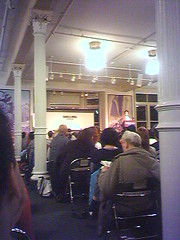I just saw Malcolm Gladwell do a book tour talk. With “The Tipping Point” and now “Blink” it’s clear he’s a student of change. In his new book he looks at the ability of the adaptive unconscious to make good decisions because it’s been trained through experience. The implications for practice and iteration are directly relevant for designers.
He says, “Decisions made very quickly can be every bit as good as decisions made cautiously and deliberately” — especially by those with expertise — but this requires “changing the environment in which the snap judgment is made.” Often this means less information is better. A mass of information is alright when planning, but when action is needed too much information brings with it dangers of bias and drowning in data.
Later… I suddenly realize Gladwell is applying neural network theory in reverse. We’ve built articificial networks modeled on the brain and train them, fine tuning the weight of each node. Then we expect the computerized versions to make decisions instantaneously, not mull it over. Gladwell seems to be saying once we’ve trained our neural networks similarly, we too can make effective instantaneous decisions.

Comments
-1 responses to “Malcolm Gladwell blinks”